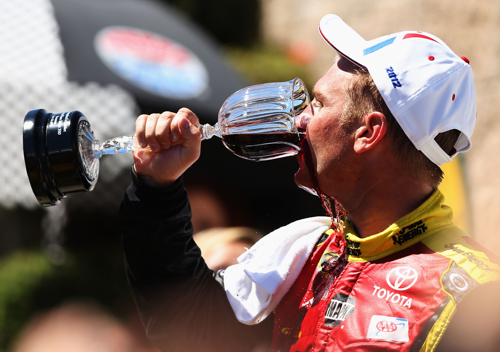[media-credit id=62 align=”alignright” width=”240″] [/media-credit]A recent, first of its kind study published in The Journal of Strength and Conditioning Research proved definitively that not only are athletic skills needed behind the wheel of a stock car, but also that there is a significant correlation between performance on the track and the length of resistance training sessions.
[/media-credit]A recent, first of its kind study published in The Journal of Strength and Conditioning Research proved definitively that not only are athletic skills needed behind the wheel of a stock car, but also that there is a significant correlation between performance on the track and the length of resistance training sessions.
The study also revealed that those stock car drivers who assessed their own fitness positively performed better on the track. Their conditioning also correlated with less fatigue and less susceptibility to injuries.
“The sport is actually more demanding now than it used to be,” four-time NASCAR Cup champion Jeff Gordon stated. “We’ve gotten smarter on the physical side of it, working out more.”
“So, I think the drivers are in a little bit better physical shape than what they used to be as far as preparing for the races.”
The study also showed that “upper body strength was identified as the most important physical ability for driving stock cars by 100% of the subjects in the study.”
“I do a lot of strength training,” Danica Patrick, NASCAR Nationwide driver, said. “I work with a trainer and he sends me programs every four or five weeks.”
“The most important thing is performing in the car so that is what I’m weight training for,” Patrick continued. “I feel that weight training is very beneficial for your physique.”
“I do two days upper and one day lower,” Patrick said. “The program changes throughout the year.”
“I take a month off at the end of the year to recover so I don’t get injured,” Patrick continued. “As the year goes on, I work on peak strength so what I do in the car is easy.”
“I think working out has to help and I’ve always felt that it helped me,” Patrick said. “I’ve always worked out since I started in racing and I work out as hard as I ever had right now.”
“I’m in as good a shape as I’ve ever been,” Patrick continued. “I think being prepared physically and mentally is a big part of racing for me. For myself, I know it helps me.”
The study revealed that “62.5% of the subjects reported cardiovascular endurance as one of the top physical demands of driving a stock car.” According to the research, this is consistent with the reports of the drivers who often feel intense fatigue, elevated heart rate and shortness of breath as a result of the physicality of their racing.
“I work with weights four days a week – just the different muscle groups and trying to get more endurance and strength,” five-time NASCAR Cup champ Jimmie Johnson said. “The mindset being that I’ll have more energy and perform better at my job.”
One important aspect of racing that the study highlighted was the need for strength training in order to assist in thermoregulation and heat tolerance. In fact, being able to cope with the temperatures in the race car was found to be the third most important physical demand of stock car racing.
“I don’t know if there’s a direct correlation but I think you might have a little bit of an edge if you can stay in shape,” NASCAR Nationwide Series reigning champion Ricky Stenhouse Jr. said. “I do work out. We have a great trainer at the shop.”
“When you’re in the seat every week, you work out every muscle,” Stenhouse Jr. continued. “The main thing is to stay hydrated in the cars and that’s what I really focus on.”
NASCAR Camping World Truck Series rookie driver Paulie Harraka agrees with his racing compatriot, especially as far as working out to deal with the heat. Harraka also added the element of dealing with the gravitational forces in the race car as another reason to include strength training in preparation for being on the track.
“Certainly as a driver, you’ve got to train for the g-forces that you feel,” Harraka said. “One lap is tough but it’s when you get to lap 150 and you’ve been in there and not able to move that you get fatigued.”
“You have to deal with that and with the heat inside the race cars.”
Finally, the study revealed that one of the major physical demands of stock car racing included hand/eye/foot coordination, reflexes and reaction time. In fact, 30% of the drivers indicated that “hand, eye, and foot coordination was an important physical demand associated with stock car racing.”
Two NASCAR drivers, Kasey Kahne and Carl Edwards, have taken this aspect of training to heart, using Dynavision™ D2, a machine that tracks and improves reaction time, peripheral awareness, hand-eye coordination and other visual-motor skills.
The D2 has a sphere of buttons that light up in random succession and the drivers have to call out the random flashing numbers in the midst of noises simulating those on the track.
“That’s the kind of environment that we race in,” Edwards said. “There is a lot of noise; you are focusing on different things.”
“You’re having to verbalize something a lot of times about the car,” Edwards continued. “So, that’s actually a good test.”
Whether strength conditioning, cardiovascular exercising or improving reaction times, the study in the Journal of Strength and Conditioning Research proves once and for all the athletic component of NASCAR racing and the correlation between working out and improving on-track performance.










Hi Mary Jo I am veri interested in this Study you are talking about in this article cause I am doing research paper in english class stating that Nascar drivers are real athletes. I have one scholary article from that same journal of strength and conditioning with the author of William Ebben. Is that the one you commented on?